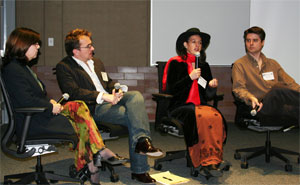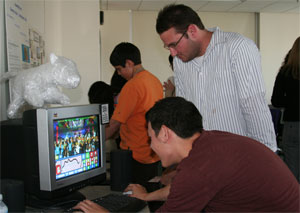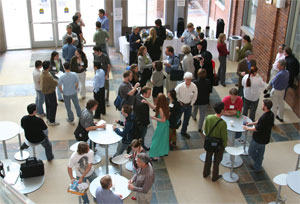UCI?s MASSIVE Summit Examines Networked Multiplayer Online Gaming
|
05.12.06 – Industry and academia put their heads together at Calit2@UCI last month to explore the cultural, creative and technical dimensions of massively multiplayer online games. MASSIVE: the Research Summit on the Future of Networked Multiplayer Games examined the fastest-growing sector of the game business – from its connections to sociology, anthropology and technology, to the challenges placed on network architectures and infrastructures.
MASSIVE was produced by UCI’s Institute for Software Research and the Game Culture & Technology Lab, sponsored by a UC Discovery Grant and the Donald Bren School of Information and Computer Sciences, and hosted by Calit2.
The event included speakers from well-known game companies, panel discussions, demo sessions and a student game-design showcase. Industry recruitment tables put game companies in touch with up-and-coming UCI student talent.
Massively multiplayer online games – known as MMOGs – generate new forms of art, production and culture, and new research questions that require input from a variety of research areas. One of the key questions posted by MASSIVE was: which of these research questions are best tackled by industry and which are best approached by academia?
|
||||
Jack Emmert, lead designer of the superhero MMOG “City of Heroes” (Cryptic Studios, NCsoft, 2003), opened the event’s keynote by positing a hypothetical question: What would an MMOG for the ancient Romans look like? This set the tone for the remaining panel sessions, each of which was followed by a lively discussion.
A number of key issues were raised. One was the need to expand the audience for MMOGs by creating more diverse game content and genres. Several participants pointed out that the addition of creative activities would broaden the appeal of MMOGs to women, an area that participants agreed could use improvement.
Another was the increasing cost of production, which is worsening with the growing expectations created by blockbuster MMOG “World of Warcraft” (Blizzard, 2004). Some participants felt that a way to mitigate this was to increase creative and production opportunities for players.
A debate also arose about the question of production value: on the one hand, higher-resolution graphics and better lighting effects are considered de rigueur for new computer games; at the same time, games with simpler graphics, such as “Whyville” (New Medeon) and “Neopets” (Neopets, Inc.) are garnering large audiences with simple 2D graphics.
The subset of casual games, often overlooked by the mainstream game industry, was also viewed as a means of expanding the audience. Some participants felt there was room for more games that were somewhere between hard-core and casual. Baby boomers were highlighted as a potential audience for these new forms and genres of MMOG. Several presenters in the morning sessions represented a sociology and anthropology viewpoint, highlighting a growing area of research in the social and cultural dynamics of games and virtual worlds.
The afternoon sessions focused on innovative approaches and technologies. “Out of the Box” examined games that take place across multiple platforms, and games as performance, a means of bringing mobile content into public space. The use of games and text-based virtual worlds, known as MUDs and MOOs, also offered an alternative use of games in the artistic sphere.
“New Production Models & Infrastructures” highlighted some of the challenges of creating and supporting MMOGs, including introducing new economic models that expand opportunities for independent developers. Two infrastructure models were presented. Also discussed were open source strategies and the San Diego Supercomputer Center ’s new server infrastructure for research.
The closing panel highlighted industry/academia collaboration with a handful of examples. UCI’s Game Culture & Technology lab showed its recent work with Santa Ana ’s Discovery Science Center . Other examples included: UC San Diego ’s CRCA’s recent collaboration with the game industry; Quicksilver’s collaboration with USC’s Institute for Creative Technology; and “Whyville,” which originated at CalTech and has enjoyed a long collaboration with UCLA’s Graduate School of Education and Information Studies.
The sessions ended with a lively conversation among all the panelists and audience members. A number of key topics emerged, including the storytelling challenges posed by MMOGs, as well as the current “creative crisis” in the game industry, which leads to innumerable “copycat” games and rare innovation.
MASSIVE participants were joined by members of HASTAC, the Humanities, Arts, Science and Technology Advanced Collaboratory, at the closing reception, where they enjoyed hands-on demos from some of the presenters and continued the discussion. A big draw was the student-created game showcase, which included a “hack” using the controller of the popular new game “Guitar Hero” (RedOctane, 2006), an adventure game designed and produced by four women ICS students at UCI, and a mobile zombie game.
Related Links
http://www.ocregister.com/ocregister/money/yourcounty/article_1112530.php
http://grandtextauto.gatech.edu/2006/04/20/notes-from-massive/



